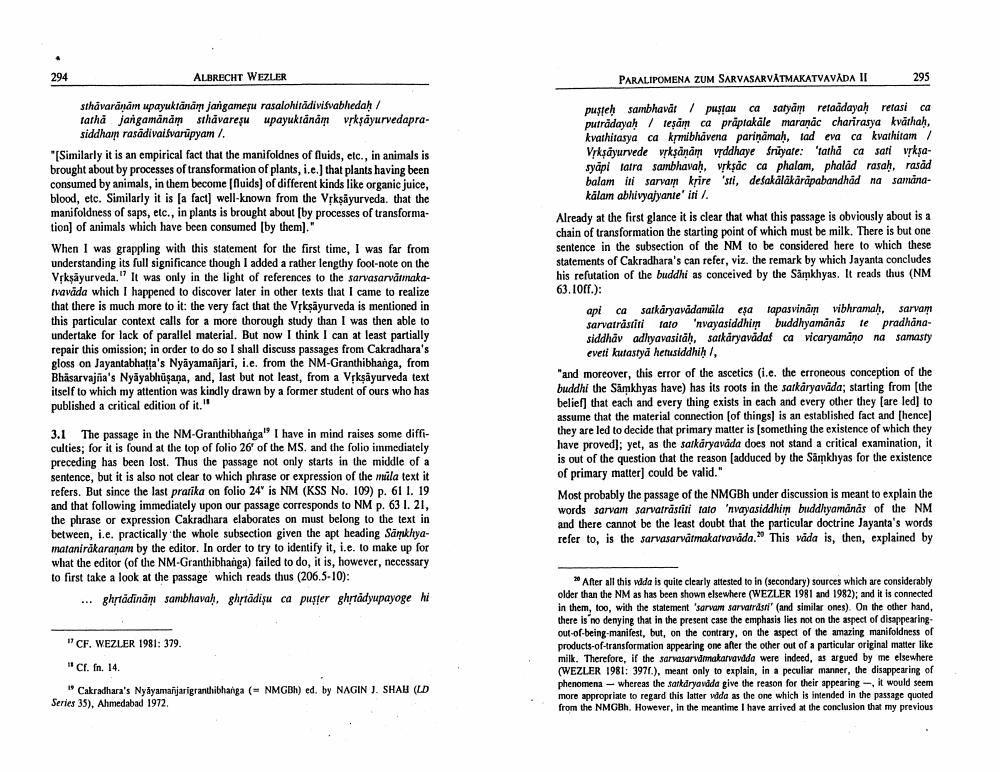Book Title: Paralipomena Zum Sarvasarvatmakatvada II Author(s): A Wezler Publisher: A Wezler View full book textPage 5
________________ 294 ALBRECHT WEZLER PARALIPOMENA ZUM SARVASARVÅTMAKATVAVADA II 295 sthavaranám spayuktäna jargamesu rasalohiddi vivabhedah/ fatha jangamanam sthavaresu upayuktanam vrkçayurvedapra. siddhan rasadivai varūpyam I. "Similarly it is an empirical fact that the manifoldnes of fluids, etc., in animals is brought about by processes of transformation of plants, i.e.) that plants having been consumed by animals, in them become (fluids) of different kinds like organic juice, blood, etc. Similarly it is la fact] well-known from the Vrksãyurveda. that the manifoldness of saps, etc., in plants is brought about (by processes of transformation) of animals which have been consumed by them)." When I was grappling with this statement for the first time, I was far from understanding its full significance though I added a rather lengthy fool-note on the Vyksãyurveda." It was only in the light of references to the sarvasarvatmakaIvavada which I happened to discover later in other texts that I came to realize that there is much more to it: the very fact that the Vrksäyurveda is mentioned in this particular context calls for a more thorough study than I was then able to undertake for lack of parallel material. But now I think I can at least partially repair this omission; in order to do so I shall discuss passages from Cakradhara's gloss on Jayantabhata's Nyayamanjari, i.e. from the NM-Granthibhanga, from Bhäsarvajia's Nyayabhișana, and, last but not least, from a Vrksãyurveda text itself to which my attention was kindly drawn by a former student of ours who has published a critical edition of it." pusteh sambhavat / pusiau casatyam retaådayah retasi ca putrådayah / teşår ca prăptakale maranác charirasya kathah, kvathitasya ca kmibhävena parinamah, tad eva ca kvathitam / Vykşayurvede vrksåņam vyddhaye friyate: 'tathd ca sativkasyapi fatra sambhavah, vkác ca phalam, phaladrasah, rasad balam ini sarvan krire 'sti, defakäläkarapabandhad na samana kalam abhivyajyante' isi/. Already at the first glance it is clear that what this passage is obviously about is a chain of transformation the starting point of which must be milk. There is but one sentence in the subsection of the NM to be considered here to which these statements of Cakradhara's can refer, viz. the remark by which Jayanta concludes his refutation of the buddhi as conceived by the Samkhyas. It reads thus (NM 63.10ff.): api ca sarkáryawadamala esa tapasvinän vibhramah, sarvam sarvatrastiil fato invayasiddhim buddhyamands te pradhana siddhavadhyavasitäh, sarkaryavādas ca vicaryamano na samasty eveti kutastyä hetusiddhihl, "and moreover, this error of the ascetics (.e. the erroneous conception of the buddhi the Samkhyas have) has its roots in the sarkaryavada; starting from the belief that each and every thing exists in each and every other they are led to assume that the material connection (of things is an established fact and (hence) they are led to decide that primary matter is something the existence of which they have proved); yet, as the sarkaryavada does not stand a critical examination, it is out of the question that the reason (adduced by the Samkhyas for the existence of primary matter) could be valid." Most probably the passage of the NMGBh under discussion is meant to explain the words sarvam sarvatrastiti tato invayasiddhim buddhyamanås of the NM and there cannot be the least doubt that the particular doctrine Jayanta's words refer to, is the sarvasarvatmakarvavada. This váda is, then, explained by 3.1 The passage in the NM-Granthibhanga" I have in mind raises some difficulties: for it is found at the top of folio 26' of the MS, and the folio immediately preceding has been lost. Thus the passage not only starts in the middle of a sentence, but it is also not clear to which phrase or expression of the mila text it refers. But since the last prarika on folio 24' is NM (KSS No. 109) p. 61 I. 19 and that following immediately upon our passage corresponds to NM p. 63 I. 21, the phrase or expression Cakradhara elaborates on must belong to the text in between, i.e. practically the whole subsection given the apt heading Sarkhyamatanirákaraṇam by the editor. In order to try to identify it, i.e. to make up for what the editor (of the NM-Granthibhanga) failed to do, it is, however, necessary to first take a look at the passage which reads thus (206.5-10): ... ghrtādinām sambhavah, ghytádişu ca puşfer ghrtadyupayoge hi "CF. WEZLER 1981: 379. After all this ydda is quite clearly attested to in secondary) sources which are considerably older than the NM as has been shown elsewhere (WEZLER 1981 and 1982), and it is connected in them, too, with the statement servam sarvards and similar ones). On the other hand, there is no denying that in the present case the emphasis lies not on the aspect of disappearingout-of-being-manifest, but, on the contrary, on the aspect of the amazing manifoldness of products-of-transformation appearing one after the other out of a particular original matter like milk. Therefore, if the sarvasaridmatanadda were indeed, as argued by me elsewhere (WEZLER 1981: 3970.), meant only to explain, in a peculia manner, the disappearing of phenomena - whereas the sarkdryavdda give the reason for their appearing it would seem more appropriate to regard this latter Ydda as the one which is intended in the passage quoted from the NMGBh. However, in the meantime I have arrived at the conclusion that my previous Cl. fn. 14. Cakradhara's Nykyamarjarigranthibhanga (NMGBh) ed. by NAGIN J. SHAU (LD Series 35). Ahmedabad 1972.Page Navigation
1 ... 3 4 5 6 7 8 9 10 11 12 13 14 15
